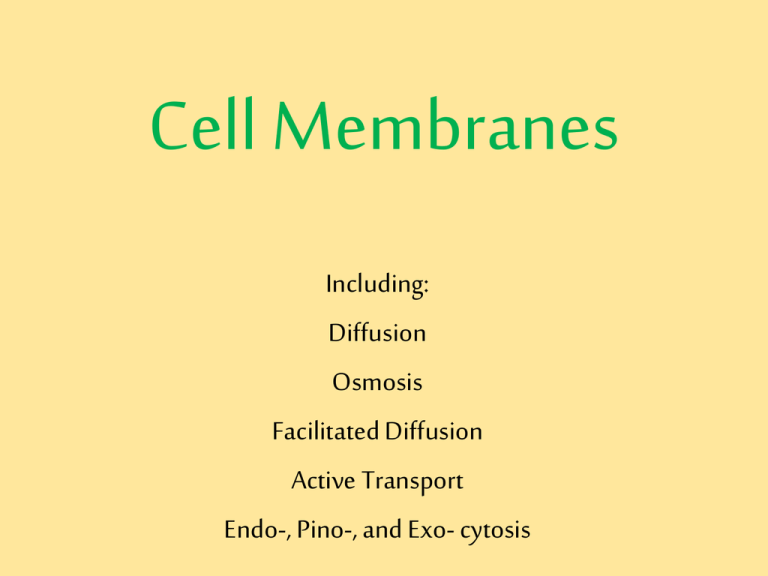Cell Membranes Including: Diffusion Osmosis
advertisement

Cell Membranes Including: Diffusion Osmosis Facilitated Diffusion Active Transport Endo-, Pino-, and Exo- cytosis Cell Membrane • Also called the plasma membrane, or "phospholipid bilayer" • Is a selectively permeable lipid bilayer found in all cells. – Selectively permeable means some molecules are allowed to go through and some are not. • It contains a wide variety of biological molecules, primarily proteins and lipids, which are involved in a vast array of cellular processes Phospholipids… …are like fats except it has a phosphate group in place of the fatty acid. This means that phospholipids have a hydrophilic head and hydrophobic tail and this is important because phospholipids self assemble in water into a bi-layer. Fluid Mosaic Model Diffusion • The process by which molecules spread from areas of high concentration, to areas of low concentration. • No energy is required • When the molecules are even throughout a space - it is called EQUILIBRIUM Diffusion across a membrane Osmosis • Osmosis is the diffusion of water through a selectively permeable membrane down its concentration gradient • From an area of high water concentration to an area of lower water concentration Osmotic Pressure The pressure required to prevent the passage of water through a semi-permeable membrane from a region of low concentration of solutes to one of higher concentration, by osmosis. Cell walls create this pressure this prevents plant cells from breaking Isotonic Solution • A solution that has the same salt concentration as the normal cells of the body and the blood. Hypertonic Solution • A solution with a higher salt concentration than in normal cells of the body and the blood Hypotonic Solution • A solution with a lower salt concentration than in normal cells of the body and the blood. Facilitated Diffusion… …is the spontaneous passage of molecules or ions across a biological membrane passing through specific membrane transport proteins. Active transport… – requires energy – Uses membrane proteins – Goes from area of low concentration to an area of high concentration Endocytosis… …is the process by which cells absorb material (molecules such as proteins) from outside the cell by engulfing it with their cell membrane • Two Types – Pinocytosis – Phagocytosis Pinocytosis • Movement of liquids into the cell Phagocytosis… movement of solids into the cell Exocytosis • …is a cellular process where cells eject waste products or chemical transmitters (such as hormones) from the interior of the cell. • Exocytosis is similar in function to Endocytosis but works in the opposite direction.






